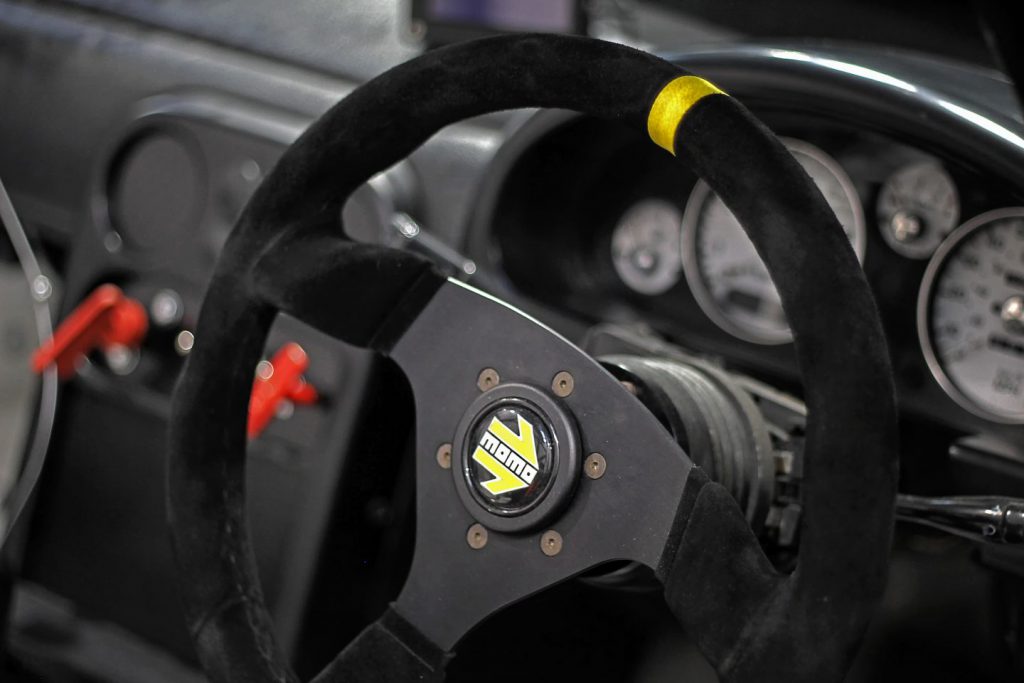
The steering wheel has been used almost since the dawn of motoring, and as a simple means of changing the direction is very hard to improve upon – and lots of people have tried. Earlier cars used a tiller, a simple lever to change direction, think of a rudder on a dinghy but generally the other way around.
The first documented use of a steering wheel was in 1894 in the Paris-Rouen race and was used by Alfred Vacheron driving a Panhard. This is generally recognised as the first official race, though some might say it was when the second car was made! The wheel must have been useful for steering around horses, pedestrians, and livestock in this race on open roads.
The phrase “motorsport improves the breed” certainly holds true. The steering wheel obviously allows directional changes but more importantly, especially for motorsport, provides the “feel” that allows the driver to sense chassis response, handling and often the level of grip. This neatly brings us to how you can change the steering wheel to improve the feel and to tailor to the driver’s taste.
How to mount a steering wheel on a production car
The standard factory wheel fitted to most cars is a one-piece assembly that includes the wheel, the mounting, the horn and airbag (if fitted). The majority have a mounting that is splined to transmit the steering movement and held in place by a single nut. Some Ford’s have a hexagon rather than a spline and some Japanese cars have a pinch bolt fixing.
The wheel will normally have a slip ring to transmit current to the horn and airbag while the wheel is turning, and will also have some means of cancelling the indicators after turning.
Aftermarket steering wheel manufacturers make a car specific mount to suit the intended vehicle. This means they don’t have to make every wheel to suit each model. The commonly used names for these are a boss kit, steering boss, steering hub or steering wheel adaptor.
The boss kit will fit the factory steering column and will have a bolt circle to match the manufacturers own wheels, and will have wiring to allow for a horn connection (except where the horn is on the stalk from the factory).
There will be no provision for the refitting or connecting the airbag. If the boss kit is for a model where all the range are equipped with airbags the boss will normally come with a resistor to extinguish the airbag warning light. Airbag removal can be dangerous, so this is best left to a professional.
Many aftermarket bosses come with a collapsible section which allows some give in the event of an accident. A few applications are too short to have this section and will be solid in this case.
The boss kits are of a length or depth that allows a slightly dished wheel to sit in a similar place to the original wheel. Fitting a fully dished wheel or a spacer will bring the wheel closer to the driver.
The boss mounting face is drilled to suit the spacing of the wheel, with some makes being interchangeable. This can be useful where a hub kit for your car and steering wheel is not listed but is by another brand. The common pitch circle diameters* are shown below:
- Mountney Classic Range 6 x 101mm
- Moto Lita 9 x 100mm
- Personal / Nardi 6 x 74mm
* Pitch circle diameter ( PCD ) is the diameter of the circle the bolts pass through
How to mount a steering wheel on race / one off vehicles
A car with a simple tube column such as a race car, auto grass special or one-off build will typically use a weld on boss. These are available with three-bolt or six-bolt fixings for the steering wheel. Typically, the three-bolt type is used on single seater and GT cars, while the six-bolt type is for production cars. This type of boss is predominately quick release to allow easier access to the vehicle.
The part of the boss to weld to the column are available in a number of sizes with 20mm, 28mm, 29.4mm, 3/4”, 5/8” and 1” the most common. These can be fitted to a simple tube type column or a production car column with machining (normally machining off the splines and the threaded end.) This is useful for rare or unusual cars where no standard bolt on type boss is available. This can also be positioned exactly where the driver requires.
The majority of weld-on bosses are without electrics, however, some of the top end quality bosses are available with electrics. Steering is very safety critical so welding or machining should always be done in a competent manner, we would suggest having professionally done or at the very least have checked by an engineer.
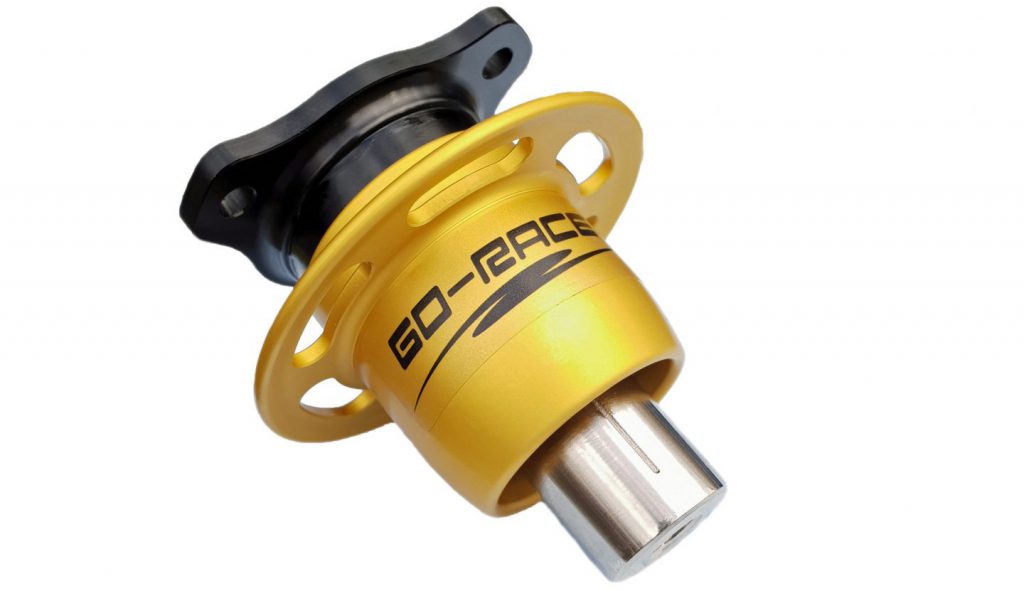
How to choose a steering wheel
There’s lots to consider when choosing the correct steering wheel for your race car. From diameter and dish to material and shape. All brands from Sabelt and OMP to Motacorsa utilise these areas and more in different ways depending on the use case of the wheel.
Diameter
The diameter is the most important dimension and will have the most influence on the steering effort and feel. Most production cars come with a wheel size that allows your 90-year-old grandmother to steer the car without too much effort so reducing the diameter will give the steering more feel and weight. The opposite can sometimes apply, and off road vehicles sometimes go bigger to lighten the steering effort at slow speeds.
Production cars without power steering normally use 350mm but some cars with very light steering will work okay with 320-330mm. Power steered cars will use 320-330 but smaller can work. Six-bolt wheels for use with a boss kit can go as small as 280mm and as large as 380mm. Single seaters and some very light kit cars using three-bolt steering bosses can use wheels from 250mm up to around 320mm.
Size is often determined by the space available and where the diameter will position the driver’s arms. A good guide on size is to check the diameter on similar cars to your own. Often the size that suits best will be where the arms fall naturally in the driving position.
Wheel diameter stated is the outside diameter. If two diameters are quoted the wheel will be flat top or flat top and bottom and the smaller diameter will be the top to bottom diameter.
Dish
The dish of the wheel is the dimension from the mounting face to the closest face of the wheel to the driver. The bigger the dimension the more the dish.
A fully dished wheel typically measures 70-95mm. This will bring the wheel much closer on a standard-length boss kit. The wheel being closer can allow more effort to be applied to the wheel. This can be very useful where the seating and pedal positioning has been changed. Most fully dished wheels are around 350mm in diameter, in smaller sizes it is difficult to achieve with short wheel spokes.
Semi or half dished wheels are typically around 30-40mm and most other wheels are classed as flat, although most of these have a slight dish of a few mm’s.
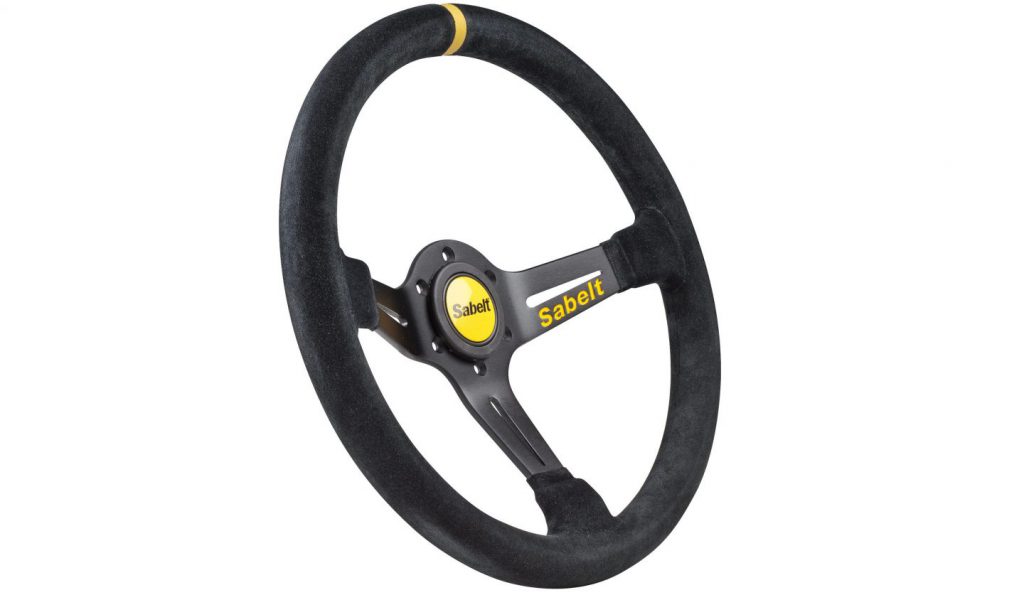
Material
The material of the rim can be suede, leather, carbon fibre, polyurethane, aluminium, and the very traditional wood. The choice is down to the drivers taste but each has their own advantages:
- Suede is almost the default choice for motorsport gloves and gives excellent grip on FIA suede palm gloves. The surface is less likely to slip with wet or sweaty hands. The suede needs more care than the other finishes but can last well if looked after.
- Leather is more durable and very grippy with leather or synthetic gloves or without gloves. Appearance is better than suede especially as it gets older.
- Carbon fibre is very light, strong, and grippy if used with FIA gloves with silicone grip inserts (generally higher end gloves). Very lightweight reduces inertia in the steering.
- Polyurethane is very similar to leather in grip and is used on budget wheels. Very durable.
- Aluminium wheels have a rough coating which is grippy with any type of glove and extremely durable, can be a bit tough on the hands for long events, but very popular for short races such as oval racing.
- Wood is grippy with leather gloves and gloves with silicone grips. Lasts well and looks period in many classic cars.
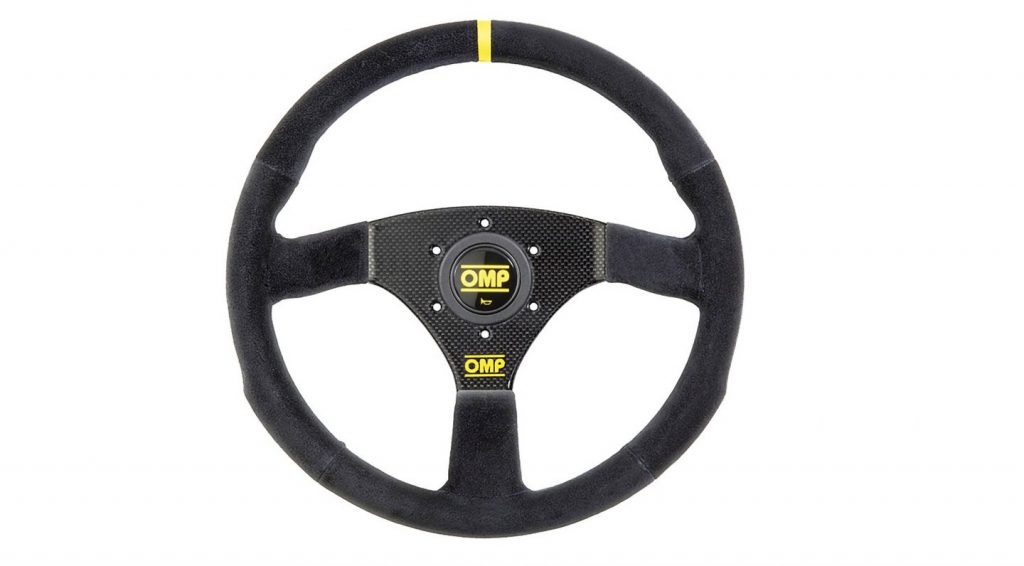
Rim Section
The rim of the wheel can be round or oval in section. The round wheels tend to give a very substantial feel and great where a lot of mechanical grip is required. A good choice for drivers with large hands.
The oval rim is more ergonomic. The rim is deeper front to back than radially so tends to feel more natural to the hand. The oval section is normally expressed as two dimensions, the larger being the front to back measurement.
Most wheels will have a moulded area for the thumbs to rest. The choice can often be down to driver preference.
Shape
The shape is typically round but some wheels have flat bottom or flat top and bottom, this can improve access especially if a quick release is not fitted. Some wheels can have a cut off top, care should be taken they are eligible for use as cut off wheels are not allowed for UK motorsport.
Wheel Mounted Dash
Formula and GT cars can make use of wheels with built in dashes such as the excellent Aim unit shown below:

Steering Wheel Accessories
Quick Release Mechanism
A car with a roll cage, door bars and a high sided bucket seat can be difficult to get in and out of. A quick release will allow the wheel to be removed to aid access and exit. A car fitted with a six-bolt boss kit can be easily changed to quick release by using a bolt to boss quick release. This will release with a collar pulled toward the driver. These will have master spline so the wheel can always put replaced in the correct alignment. Some come with connections for electrics and some without.
Cars that have a tube column will require a weld on quick release boss as mentioned above. A great anti-theft feature when the car is stored.
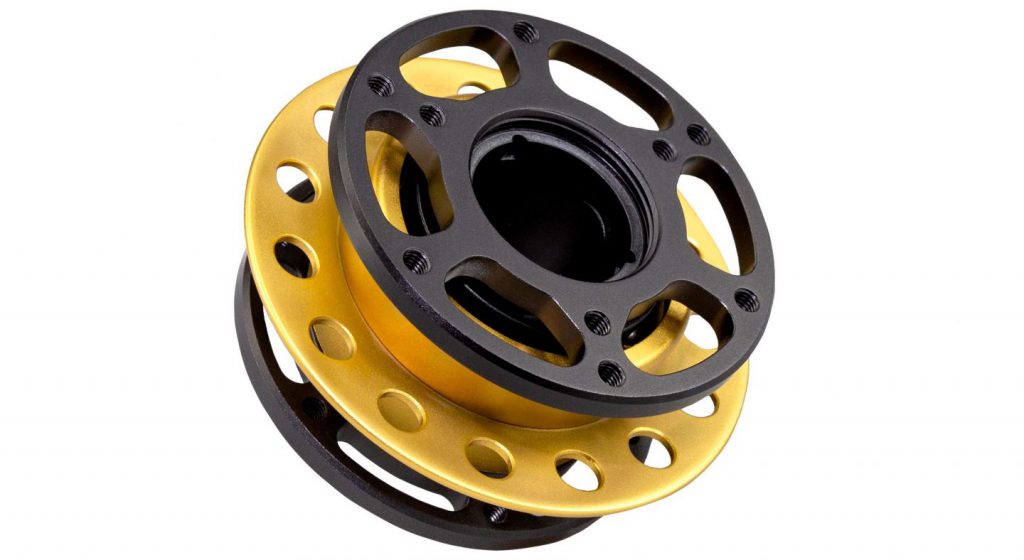
Spacers
A six-bolt boss can take a choice of spacers to fine tune the driving position. The simplest is a fixed spacer available in many depths. These can be as little as 10mm and go right up to 120mm. An adjustable spacer allows the wheel to be spaced from 24mm to 70mm and can be locked in place once the optimum spacing is found. Momo even offer an eccentric spacer if the wheel needs offsetting up or down at rest. Cars with 3 bolt fixing can use fixed spacers from 12mm to 50mm and again an eccentric spacer is available.
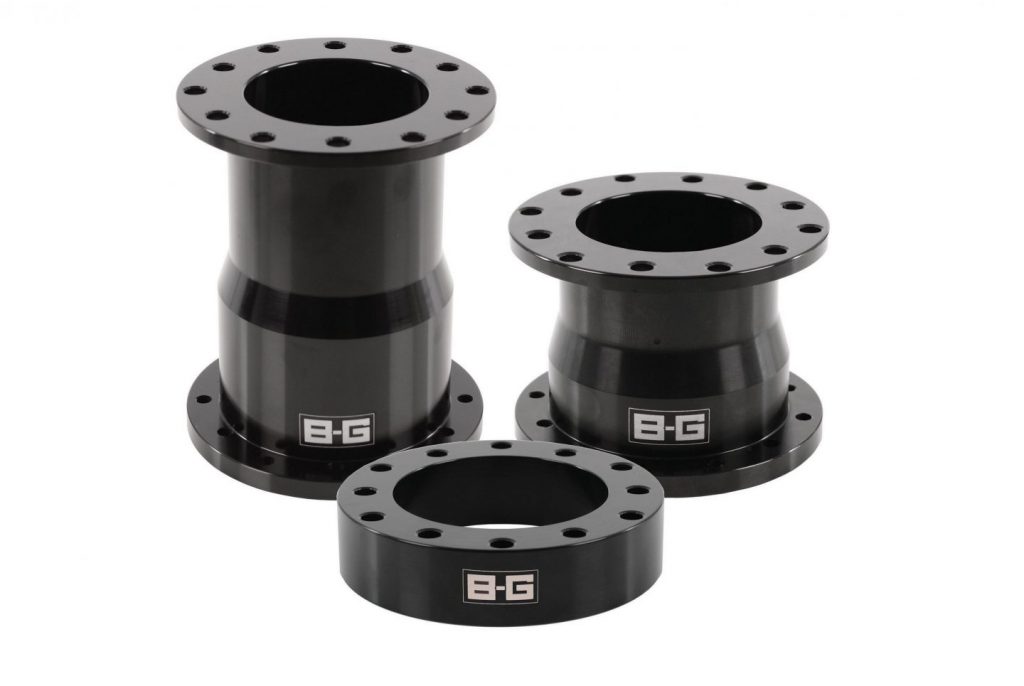
Buttons / controls
Cars using the six-bolt boss can use horn buttons fixed in place between the wheel and boss kit. Cars needing many more controls can use the excellent Summit Technologies Raptor or the Cartek system that uses buttons that send a signal to a control box negating the need for lots of electrics running down the steering column. If a simple switch or a button is added to the steering wheel for a basic set up a curly cable / lead can simplify connecting the wiring.

Airbag Resistors
If a car has a boss kit fitted and the airbag warning light is staying on, a resistor will allow this to be disabled.
Adapters
There are adapters available to convert a six-bolt boss with the common 6x70mm bolt pattern to allow the use of three bolt wheels or the other way around. They are also available to allow the use of a Moto Lita or Nardi / Personal wheels.
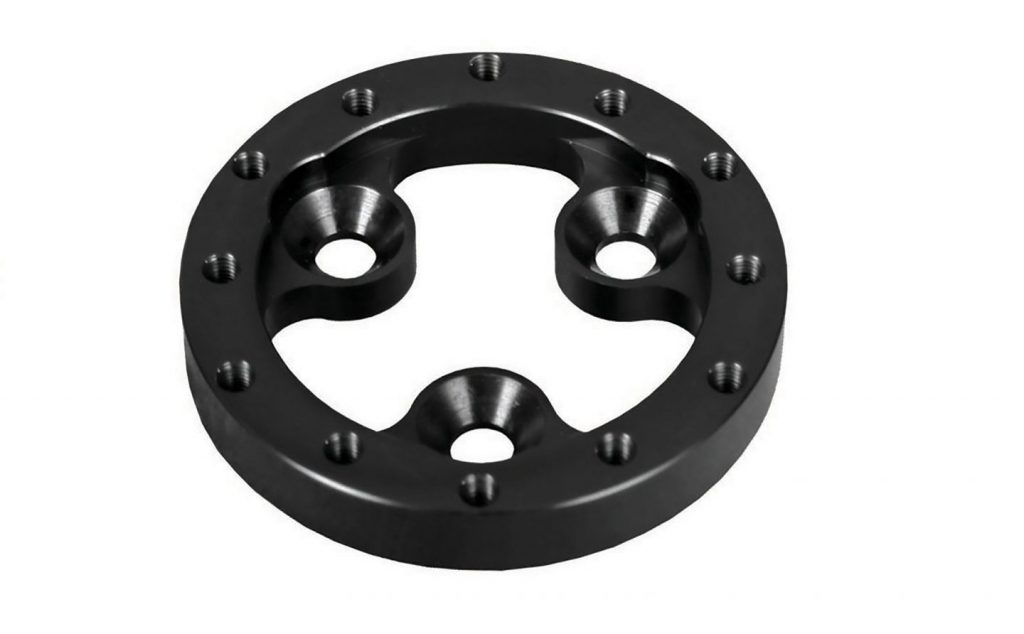
Steering Wheel Covers
Universal covers allow the wheel to be kept clean when working on the car and the car needs to be moved etc.
In conclusion
This article should cover most of the commonly asked questions relating to choosing and fitting a steering wheel. However, we are happy to answer any questions you may have.
Enjoyed this? Read more of our latest news:
- Motacorsa Steering Wheels: Quality and Affordability Combined
- What Are The Different Types Of Kart Racing? The Complete Guide
- Step By Step Guide To Get A Motorsport Licence
Where To Next?
Looking for the latest motorsport parts and accessories? Check out our wide range from top brands.
Come and visit us at our store, showroom and fitting centre in Wrexham.
Want to know more about our story? Learn about who we are and why we’ve been driven by passion for over 50 years.
Interested in everything we do? Catch up on all the latest Demon Tweeks news.
